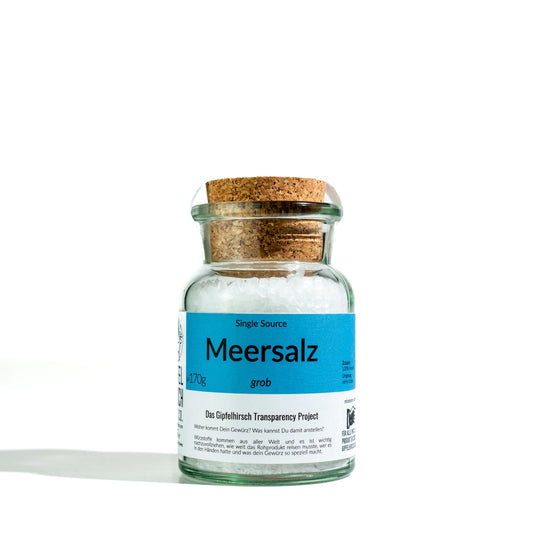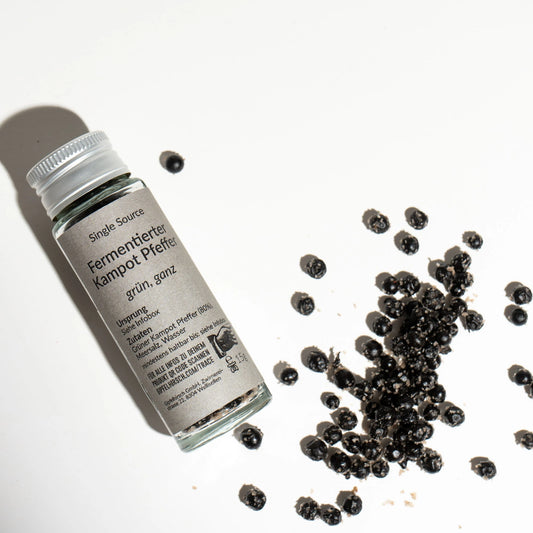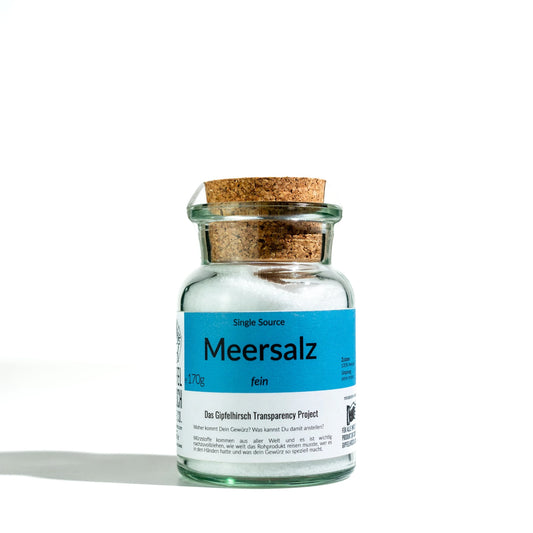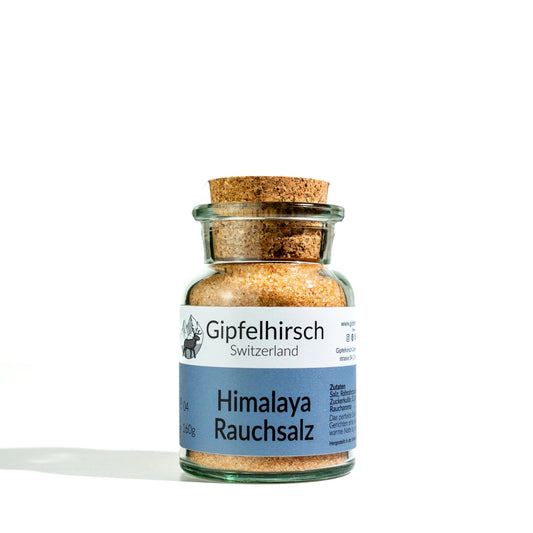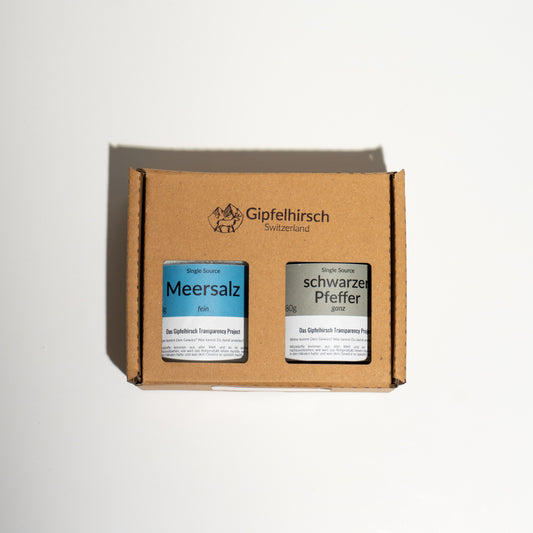Kategorie: Salze
Pimp your Kochkünste mit unseren exquisiten Salzen. Aus den besten Regionen, bietet jede Sorte ein einzigartiges Geschmacksprofil und eine Textur, die jedes Gericht aufwertet. Vom groben Crunch des Meersalzes bis zu den zarten Flakes des Fleur de Sel – unsere Salze sind perfekt zum Würzen, Verfeinern und als Gourmet-Geschenke.
Entdecke unser geräuchertes Himalaya-Salz für eine besondere Tiefe oder probiere unser fermentiertes Kampot-Pfeffer mit Meersalz für einen aufregenden Twist. Egal, ob du ein erfahrener Koch oder ein Hobby-Koch bist, wir haben das passende Salz für dich. Schau dir auch unsere Salt and Pepper Basic und Deluxe Bundles an, die die Essentials für die neue Küchenausstattung bieten – perfekt für Freunde, Kollegen und Liebste. Und für den Salzliebhaber haben wir unsere besten Produkte im Salz Deluxe Geschenkeset gebündelt. Ein wirklich feiner Weg, um zu salzen und einzulegen.
-
Grobes Meersalz
Normaler Preis CHF 4.00Normaler PreisGrundpreis entspricht CHF 23.53 / pro kg -
Fermentierter Kampot Pfeffer
Normaler Preis CHF 10.00Normaler PreisGrundpreis entspricht CHF 66.67 / pro 100g -
Feines Meersalz
Normaler Preis CHF 4.00Normaler PreisGrundpreis entspricht CHF 2.35 / pro 100g -
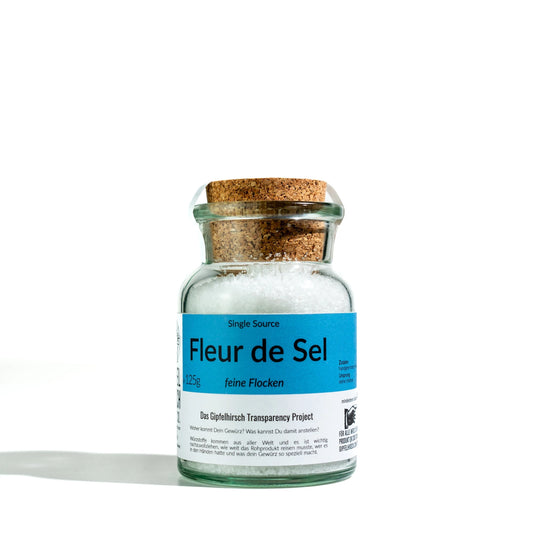 Ausverkauft
AusverkauftFleur de Sel
Normaler Preis CHF 9.00Normaler PreisGrundpreis entspricht CHF 7.20 / pro 100g -
Himalaya Rauchsalz
Normaler Preis CHF 7.00Normaler PreisGrundpreis entspricht CHF 4.38 / pro 100g -
Salz und Pfeffer Basics Geschenkset
Normaler Preis CHF 17.00Normaler PreisGrundpreis entspricht CHF 6.80 / pro 100g -
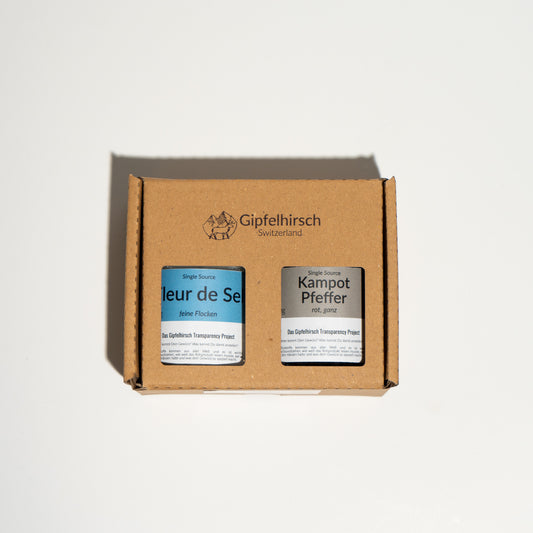 Ausverkauft
AusverkauftSalz und Pfeffer Deluxe Geschenkset
Normaler Preis CHF 30.00Normaler PreisGrundpreis entspricht CHF 12.00 / pro 100g -
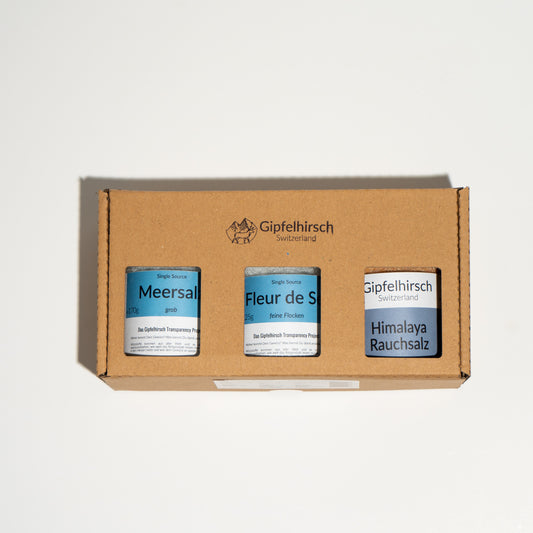 Ausverkauft
AusverkauftSalz Deluxe Geschenkset
Normaler Preis CHF 25.00Normaler PreisGrundpreis entspricht CHF 5.49 / pro 100g
Das wichtige Mineral in unserer Nahrung
Salzwissen
Die besten Salze aus aller Welt
Salz ist eine der weltweit am häufigsten verwendeten Zutaten, dennoch gibt es es in einer unglaublichen Vielfalt an Formen, jede mit ihrer eigenen einzigartigen Textur und ihrem eigenen Geschmack: Von Fleur de Sel bis zu Salzpyramiden, über blaues Saphirsalz bis hin zum eleganten Himalaya-Salz – die Vielfalt der Salzsorten ist nahezu unendlich, und jede verleiht auf ihre eigene Art einen salzigen Geschmack.
Auch die Herstellungsprozesse von Salz sind vielfältig und einzigartig: Von einem einfachen Salzbergwerk im Berg bis hin zur Verdunstung von Meerwasser gibt es viele Möglichkeiten, das weisse Mineral zu gewinnen. In manchen Kulturen gibt es sogar noch einzigartigere Möglichkeiten, Salz weiter zu verfeinern, wie dies bei koreanischem Bambussalz oder geräucherten Salzen der Fall ist. Und dann sind da noch die Gewürzmischungen – Salz kann eine entscheidende Rolle spielen, auch wenn manche lieber separat salzen.
Wir haben eine ganze Menge mehr Informationen über die Ursprünge und die Herstellung von Salz in unserer ' Leitfaden zum Salz Blog-Post-Serie
Das einzigartige weisse Gold
Salz ist nicht nur ein wichtiges Mineral für den menschlichen Körper, sondern auch wichtig in der Kultur. Aus diesem Grund ist es für uns so essentiell: Salz spielt eine entscheidende Rolle bei der Aufrechterhaltung des Flüssigkeitshaushalts des Körpers, unterstützt die Nervenübertragung und die Muskelfunktion. Darüber hinaus verändert und intensiviert Salz den Geschmack unserer Speisen. Schon eine kleine Prise kann die Süsse in Speisen verstärken , die Bitterkeit verringern und alle Elemente eines Gerichts miteinander verbinden. Es ist fast so, als ob unsere Zungen genau auf diese spezielle Rolle des Salzes trainiert ist.
Salz, das historisch als weisses Gold bekannt war, war einst so wertvoll, dass es wie eine Währung gehandelt wurde. Heute halten wir es zwar oft für selbstverständlich, aber seine Bedeutung in der Küche ist so stark wie eh und je. Ob du nun zum Schluss noch Fleur de Sel darüber streuen oder feines Meersalz in einem Rezept verwendest, Salz ist gekommen, um zu bleiben, und wir sind sehr glücklich darüber.
Zu viel Salz! Und jetzt?
Das kennen wir alle: Du probierst deom Gericht und stellst fest, dass es zu salzig ist. Aber keine Sorge, es gibt mehrere Möglichkeiten, das zu retten. Wenn sich das Salz auf der Oberfläche befindet – beispielsweise auf gegrilltem Gemüse oder einem hartgekochten Ei – kannst due es manchmal einfach abkratzen. Bei flüssigen Gerichten wie Suppen oder Eintöpfen kannst du das Gericht unter Umständen verdünnen, indem du mehr Wasser, Brühe oder einen Schuss Rahm hinzufügst. Dadurch wird die Gesamtsalzkonzentration verringert, ohne den Geschmack zu beeinträchtigen. Wenn das Gericht trotzdem noch zu salzig schmeckt, kannst du es mit einer Spur Säure ausgleichen – versuch es mit einem Spritzer Zitronensaft oder einem Schuss Essig. Alternativ kann eine kleine Menge Süsse, beispielsweise eine Prise Zucker oder Honig, helfen, das Salz auszugleichen. Beim Kochen ist es immer besser, Salz nach und nach hinzuzufügen und zwischendurch zu probieren, aber mit diesen Tricks bist du für jede salzige Situation gerüstet.
So verwendest du Salz am besten
Salz ist viel mehr als nur ein Gewürz – es ist ein unverzichtbares Hilfsmittel bei vielen Kochtechniken - und ganz strikt gesehen ist Salz eigentlich gar kein Gewürz, sondern ein Mineral.
Bei der Milchsäure-Fermentation schafft Salz eine Umgebung, in der nützliche Bakterien gedeihen können - die LAB Bakterien, während schädliche Bakterien das Essen nicht verderben. Mit dieser Technik werden klassische Lebensmittel wie Sauerkraut und Kimchi hergestellt. Wir verwenden diese Art der Fermentation für alle unsere Hotsauces. Wenn du mehr erfahren möchtest: Wir haben einen detaillierten Blogbeitrag über Salz bei der Milchsäuregärung unserer Hotsaucen geschrieben.
Salz ist auch beim Einlegen unverzichtbar, da es dem Gemüse Feuchtigkeit entzieht und ihm einen salzigen Geschmack verleiht. Feines Salz eignet sich hierfür am besten, da es mehr Oberfläche bietet und sich schneller auflöst.
Wenn du dich total inspiriert fühlst, solltest du mal dein eigenes aromatisiertes Salz herstellen - Hierfür einfach Kräuter, Gewürze und Zitrusschalen zu Salzen mischen, mörsern und abfüllen. Diese Salze eignen sich super um Aroma-Nuancen aufzubauen und sind super als Geschenk für Feinschmecker geeignet, da sich diese aromatisieren Salze lange halten. Hierfür empfehlen wir grobes Salz , da es zusammen mit Ihren Aromastoffen in einem Mörser feiner gemacht werden kann und sich so alles gut vermischt.
Eine weitere Verwendung von Salz ist das Einlegen in Salzlake, wodurch Fleisch zarter und von innen heraus würziger wird. Egal, ob du Poulet, einen Schmorbraten zubereitest: das Einlegen in Meersalz macht Fleisch geschmackvoller und saftiger.
Schliesslich eignet sich Salz auch hervorragend, um Gemüse wie Gurken, Auberginen oder Zucchini das Wasser zu entziehen, ihnen so im Salat ihre Knackigkeit zu verleihen oder sie perfekt beim Braten zuzubereiten.

